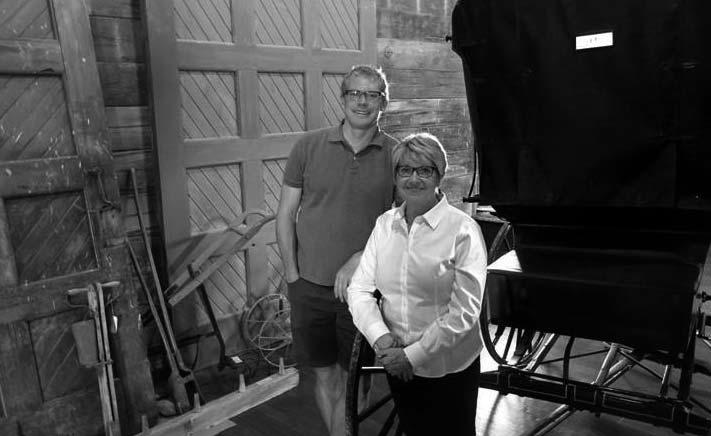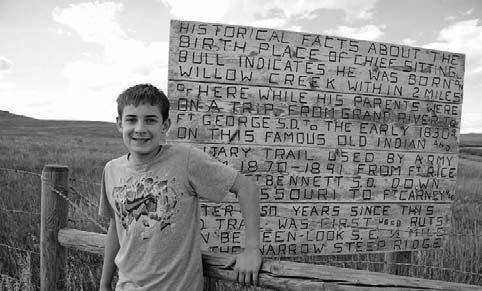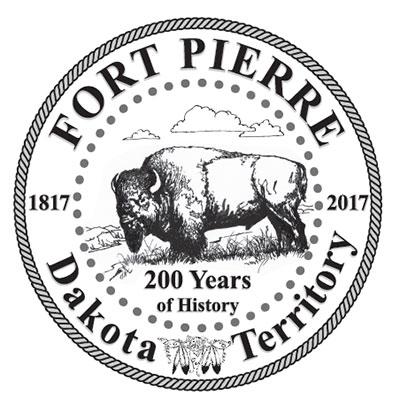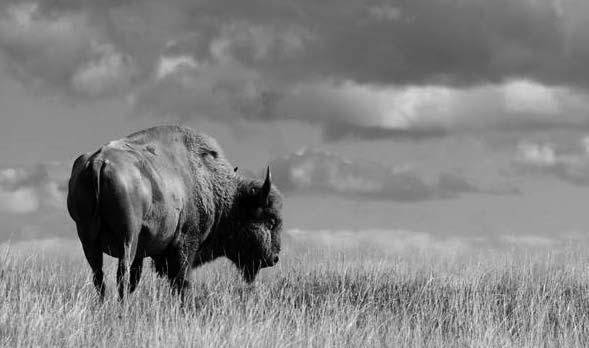
14 minute read
Fort Pierre: Celebrating its Bicentennial
200 Years a Town
Fort Pierre has a history of partying, and it doesn’t plan to disappoint anyone in 2017
Advertisement
Story by Katie Hunhoff | Photos by Bernie Hunhoff Fort LaFramboise eventually fizzled but in 1832 it was rebuilt as Fort Pierre Chouteau, named for a principal owner of the famed American Fur Company. Chouteau’s post prospered for decades, and became the midway meeting place connecting St. Louis with a number of smaller posts to the north and west in today’s Montana and North Dakota.
The traders and travelers were a colorful and boisterous bunch. In 1850, French artist M.E. Girardin visited and later wrote a detailed account of a dinner and dance held to celebrate the arrival of a steamboat: “The fires are lighted in the middle of the fort. They make great piles of pancakes over which they pour copious libations. Two violin players, one a Canadian, the other Irish, perched on the top of a barrel, recall to me country weddings in my own land. All take part in the dance: employees, hunters, half-breeds, negroes, mulattoes and Indians; and all these figures, white, yellow, black, copper colored and brick colored, lighted by the reddish flame and excited by a new distribution of whisky, have about them something really diabolical.”
Chouteau pioneered the use of steamboats on the long and treacherous Missouri. Though boat captains and crews were befuddled by high water, low water, strong currents and submerged stumps, their cargo of pelts and hides made Chouteau a rich man until the beaver and buffalo began to disappear. By 1855, he was losing money so he sold the site to the U.S. government for use as a frontier army post. Mayor Gloria Hanson puts Fort Pierre’s early history in perspective like this: “Thirty-three years before the Declaration of Independence was signed two French guys claimed it,” she says. “When the fort was established, Napoleon was occupying Europe, the War of 1812 was raging, Lewis and Clark were making their trek, the Louisiana Purchase was being negotiated and then you have Fort Pierre being settled. The history just blows me away,” she says.
We met the energetic Hanson on a sunny afternoon at the popular Silver Spur, a legendary rough-and-tumble nightspot that finally closed its doors. It has since reopened as a family-friendly restaurant and steakhouse. An outdoor patio behind the Spur overlooks the Missouri shoreline where Lewis and Clark got a scare from the Teton Sioux in 1804. Flags and a memorial mark the historic encounter in today’s Fischer’s Lilly Park, located at the mouth of the Bad River. Kids were playing in the park and fishing from a footbridge that connects to the historic downtown. Beyond the park, a rodeo was in progress at the Stanley
Six of last years 15 top rodeo bronc riders rode saddles made by David Dahl, who was had a a shop on Deadwood Street since the 1970s. Dahl, the state’s 1968 saddle bronc champ, makes a saddle a week thanks to a little help from his grandson, Drew Harper.
STORY BY KATIE HUNHOFF | PHOTOS BY BERNIE HUNHOFF
SOUTH DAKOTA’S OLDEST ORGANIZED town, Fort Pierre, is not resting on its historical laurels; the Missouri River city aims to start its third century with a bang. Two hundred years ago, the site of today’s Fort Pierre became a community of sorts when Joseph LaFramboise opened a trading post at the junction of the Bad and Missouri rivers. It was just 74 years after the Verendrye brothers had buried a lead plate on a nearby bluff claiming the region for France.

Chris Maxwell and Mayor Gloria Hanson, pictured in the renovated railroad depot, are planning Fort Pierre’s bicentennial celebration.
County Fairgrounds, which is also used throughout the year for hockey, horse racing, circuses, concerts and other activities.
Over the sounds of the kids in the park, we discussed Fort Pierre’s 200th birthday plans with Mayor Hanson. John Duffy, a local attorney with strong roots in Fort Pierre, and his wife, Patti, joined us along with Fort Pierre newcomer Chris Maxwell, who chairs the bicentennial planning committee.
Duffy shares his affection for his hometown by guiding local history tours along with Verendrye Museum Board Chairman Darby Nutter and historian Karl Fischer. He says they struggle to fit all the stories into a 90-minute bus tour. The historians tell visitors about the Verendrye Plate, the old forts, the Fort Pierre to Deadwood Trail, Scotty Philip (the man who saved the buffalo), rodeo champ Casey Tibbs and the river captains and gamblers who traveled the Missouri. “A million hands of poker were played in Fort Pierre before Deadwood even existed,” Duffy says.
In his History of the United Church of Christ in South Dakota 1869-1976, writer Edward C. Ehrensperger recounted a quote from the Rev. Stewart Sheldon after he arrived in Fort Pierre in 1880: “… a strange mixture of Americans, English, Irish, Swedes, Norwegians, Russians, Poles, French, Canadians, half-breeds, Indians, and what not …. Protestants, Catholics, Spiritualists, Moralists, Liberals, Free lovers, Ingersolites, Nothing-arins, and how many others I do not know …. Nearly all the people were in hot and eager pursuit after the almighty dollar! Freighters and cowboys and adventurers from nearly all over the world were duly represented, and there was one continued white heat of excitement week days, Sabbath days, and all. The night before I got there two young men, stimulated by whiskey, drew their pistols on each other in a miserable dance house, and one of them fell dead at the feet of his assailant, and in a few hours was buried on the hillside just back of the town, without hardly more ceremony than if it had been the burial of a dog!”
The Reverend, apparently an optimist, found a way to conclude his report on a positive note: “It was indeed firstclass missionary ground without any mistake.”
Fort Pierre’s reputation for partying continued well into the 20th century. The clock is a contributing factor: Pierre, the state’s capital city, sits on the east side of the Missouri in the Central Time Zone while Fort Pierre, on the western shore, is on Mountain Time, at least in the case of “last call” for bars.
“Fort Pierre has always been an evening place. Bars are Wagon trains and pageantry will be a part of Fort Pierre’s bicentennial, thanks to local cowboys and re-enactors like (from left) history writer Bill Markley, Kristi Vensand-Hall and Terry Hall.



The Fort Pierre to Deadwood Trail is marked by signs made decades ago by the Norman family. Gaylord Norman and Deb Schiefelbein are helping to restore the markers.
open to 3 a.m. and it’s known as a place to go late,” says Duffy. “Fort Pierre history from fur trappers to gold miners to dam builders has a reputation well-earned for a hard drinking town.”
For decades, his uncle Ed Duffy ran the famed Chateau Bar & Restaurant. Like the Silver Spur, it became famous for its mix of cowboys, blue collar types and politicians who sometimes escaped from Pierre, across the river, for privacy as they worked their legislative deals. Continuing the tradition of welcoming guests and throwing parties, our lunch companions at the Silver Spur discussed big plans for the 200th celebration, being held September 15-17. Duffy says the bicentennial will help reinforce knowledge of Fort Pierre’s history along with new development by connecting people. “The anniversary draws people to become involved and is bringing the town together. We have a lot of young families, retired families and professionals. Eighty-five percent of residents work in Pierre. This is the time to draw everyone together.”

Sitting Bull’s Birthplace is marked on Evan Nordstrom’s family ranch.

Hanson agrees that the celebration is time to move Fort Pierre in a new direction. “We have never done a good job of capitalizing on our rich history. Last year, for example, for a history field trip, students went to Pierre. I want our kids to have a ‘Don’t mess with Texas’ attitude about their hometown. So if they see trash in the street it would make them mad. I want to develop a passion for this place with everyone understanding how unique and special Fort Pierre is.”
Maxwell, who moved to Fort Pierre five years ago, sees the challenges from a newcomer’s perspective. “I’m into it now,” says Maxwell. “I’m telling people who live here all the things that are here.” He says a lot of developments are combining to create big momentum for the town’s 200th birthday and beyond.
One example is a stylish 90-foot paddlewheeler named Horizon. “The steamboat will be a permanent fixture docked in the Fort Pierre and Pierre area,” Maxwell says. “Plans are that it will be taken out on regular chartered trips, along with hopefully being a part of some ongoing history and dinner cruises.” Horizon is the dream of Caleb Gilkerson, an interesting adventurer who also makes a business of diving in the river. He is also a fishing guide, provides boat charters and tours. He purchased Horizon in St. Louis and coordinated the voyage upriver this spring. � The community has more excitement in the works, including construction of a marina close to the downtown, a summer farmer’s market and a sculpture series of historical figures, beginning with the town’s namesake Pierre Chouteau. Recently a new restaurant and convention center, Drifters, opened on the river.
The town’s original railroad depot has been returned just in time for the celebration. The wood depot was built in 1906, but after it closed in 1964 Shirley Miller of Mud Butte moved it to his ranch and used it for sheep shearing and wool storage. Fortunately, he took good care of the depot and he happily arranged for its return when the Verendrye Museum in Fort Pierre expressed an interest. After a $1 million renovation, the depot looks like it did in its heyday. But steamboats played an even bigger role than trains in the community’s early years. Fort Pierre’s downtown was even designed as a port city. The streets are at an angle to make it easier for workers to transport goods from the

The Duffy children (from left: Cormac, Maddie, Lis and Eddie) have a panoramic view of Fort Pierre from a hill above their family’s historic home. Brothers Karl (left) and Bill Fischer, local businessman and historians, trace their family history in Fort Pierre to 1889 when their grandfather arrived. They are pictured by the historic Stockgrowers Bank, a signature building in the city.



Fort Pierre attracts interesting characters like Marty Hallock, a contemporary artist who sculpts with copper and other metals.
steamboats. “I say the steamboats were our city planners,” laughs Hanson. The alleys were created 40 feet wide to give plenty of room to load and unload cargo.
Most renovations happening in the historic downtown are private enterprise, says Hanson, like the renovation of the 1903 Stock Growers Bank, a brick beauty that now houses a farm commodities business and other offices. Three of the Stock Growers’ four original vaults are still in use. Scotty Philip, the pioneer who saved the buffalo, once had an office there.
Several blocks from the Stock Growers’, artist Marty Hallock has opened 605 Studios. He creates unusual sculptures on commission, using wood, copper, polished nickel and other found materials. Across the street, the Dakota Emporium Trading Post sells Native American crafts as well as beads and leathers for artists.
Despite the progress of recent years, the Duffys and others lament that there are still a few basics missing. “Just a cup of coffee will get people downtown,” says Patti, but there’s no such place today except for gas stations and bars.
Coffee or not, make no mistake that the Fort Pierre community will remain true to its heritage by hosting a big 200th birthday party. Music is planned throughout the summer. The Silver Spur has been holding concerts near the patio that overlooks the river. The band Hairball performs June 10 and country act Diamond Rio is booked for August 4. Drifters, the new convention center, has local bands scheduled throughout the summer. In September, the community will hold a weekend long celebration with a wagon train trip highlighting historic sites, a parade, a steak feed, arts festival, helicopter rides and a rodeo. If you’re in town be sure to stop by the newly renovated Silver Spur and also the old Chateau which is slated to open sometime before the anniversary. It was purchased from the Duffys by Shane Mattheis, who plans to continue the Chateau’s legacy with its famous onion ring recipe. These two establishments were for many years two landmarks for Fort Pierre, and both sadly closed. This summer is a perfect time for them to reopen, among the celebrations and excitement of the bicentennial.

Curt Mortenson lives north of Fort Pierre, near a cottonwood tree that steamboats were moored to in the 1880s. The Mortenson family traces its lineage to Pierre Chouteau, the town’s namesake.
Reprinted with permission from the May/June 2017 issue of South Dakota Magazine.

Fort Pierre’s 200 Years
1817– Fort LaFramboise is built as a trading post near the mouth of the Bad River in today’s Fort Pierre.
1832 – Fort Pierre Chouteau trading post is established, and the American Fur Company organizes the community of Fort Pierre.
1840 – First church service held by Stephen R. Riggs.
1850-1851 – Cholera outbreak plagues Fort Pierre.
1855/1856– The United States Army purchases Fort Pierre Chouteau and Gen. Harney and his troops suffer a cold winter at Fort Pierre. Harney called a Peace Council in 1856 that succeeded until 1862. An estimated 7,000 Indians attended and set up tipis around the old fort.
1857 – First white child is born at the post.
1861 – Dakota Territory is created.
1868– The Great Sioux Reservation is established through the Fort Laramie Treaty.
1870 – First school opens.
1876 – Gold is discovered in the Hills, and the Fort Pierre to Deadwood Trail becomes a busy roadway, moving travelers and freight west.
1881 – A spring flood expands the river to over 2 miles wide.
1886– The Deadwood Trail era comes to an end when the Chicago and North Western Railroad bypasses Pierre and Fort Pierre with a line from Nebraska to Deadwood.
1883– Frederick Dupree, fearing the near extinction of the wild buffalo, captures five calves.
1889 – South Dakota becomes a state on Nov. 2 and Congress opens lands to homesteaders that had been promised to Native Americans.
1898 – Scotty Philip buys Fred Dupree’s buffalo and moves the herd to his ranch near Fort Pierre. Most buffalo in North America can be traced to the Dupree/Philip herd.
1903– Fort Pierre is booming, with 18 businesses on Main Avenue and 26 on Deadwood Street. 1907 – The Chicago & North Western Railroad builds a bridge from Pierre to Fort Pierre, connecting East with West and completing 170 miles of track between Pierre and Rapid City.
1913 – Schoolchildren find the Verendrye plate that was buried on a hilltop in 1743.
1929 – Rodeo legend Casey Tibbs is born 50 miles north of Pierre.
1947– Fort Pierre Livestock Auction is built. Friday cattle sales draw buyers from hundreds of miles away.
1948– Construction begins on Oahe Dam. It is finished in 1959 and dedicated by President Kennedy in 1962. Fishing and water recreation booms.
1952 – Another bad flood sends 2 feet of water into the homes and businesses of Pierre and Fort Pierre.
1989 – Dances with Wolves is filmed at Roy Houck’s buffalo ranch outside of Fort Pierre.
1998 – Fort Pierre’s first canals are dug, and upscale housing developments begin.
2009 – The Casey Tibbs Rodeo Center and Mattie Goff Newcombe Conference Center opens.
2011 – Another flood plagues Fort Pierre and Pierre, after record amounts of snow and rain fall in Montana and Wyoming. The flood ravages homes and businesses the entire summer.
2017 – Fort Pierre celebrates its 200th year as a community.

The history of the majestic buffalo is closely tied to Fort Pierre, thanks to pioneer ranchers Fred Dupree and Scotty Philip. Today several herds live in the Missouri River breaks of Stanley County; including a light-haired group on the Eric Nordstrom Ranch.










